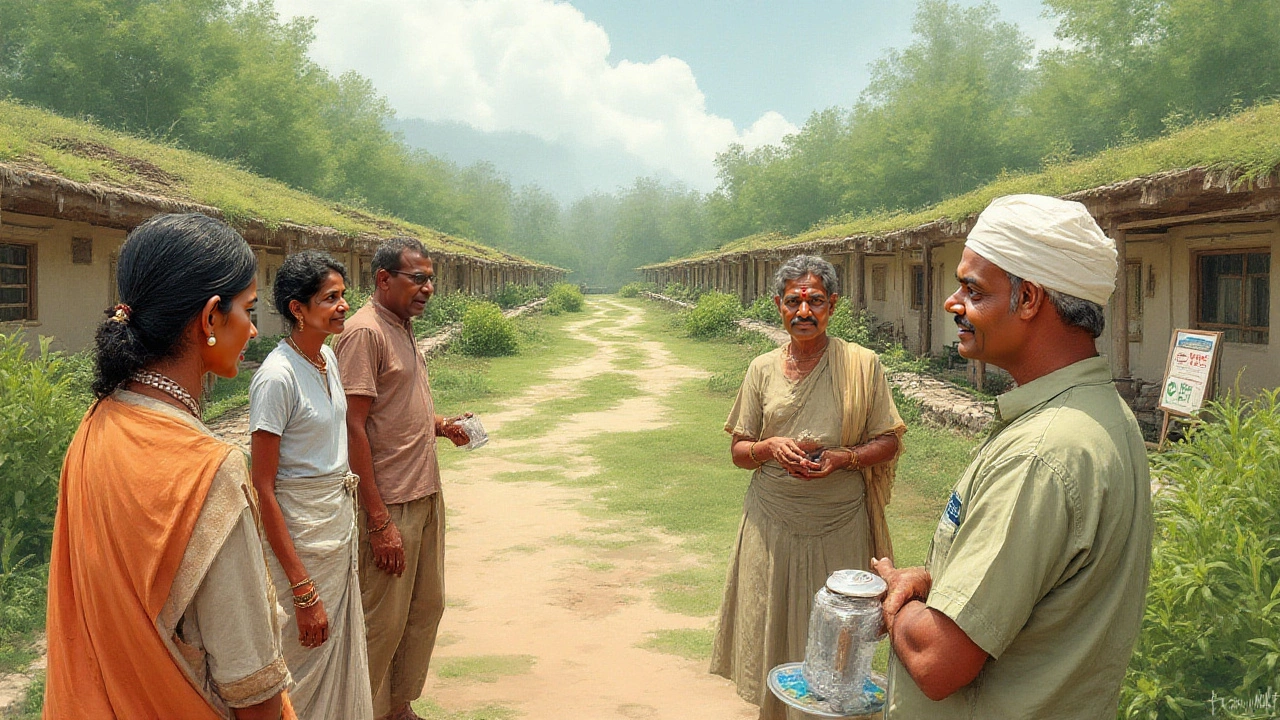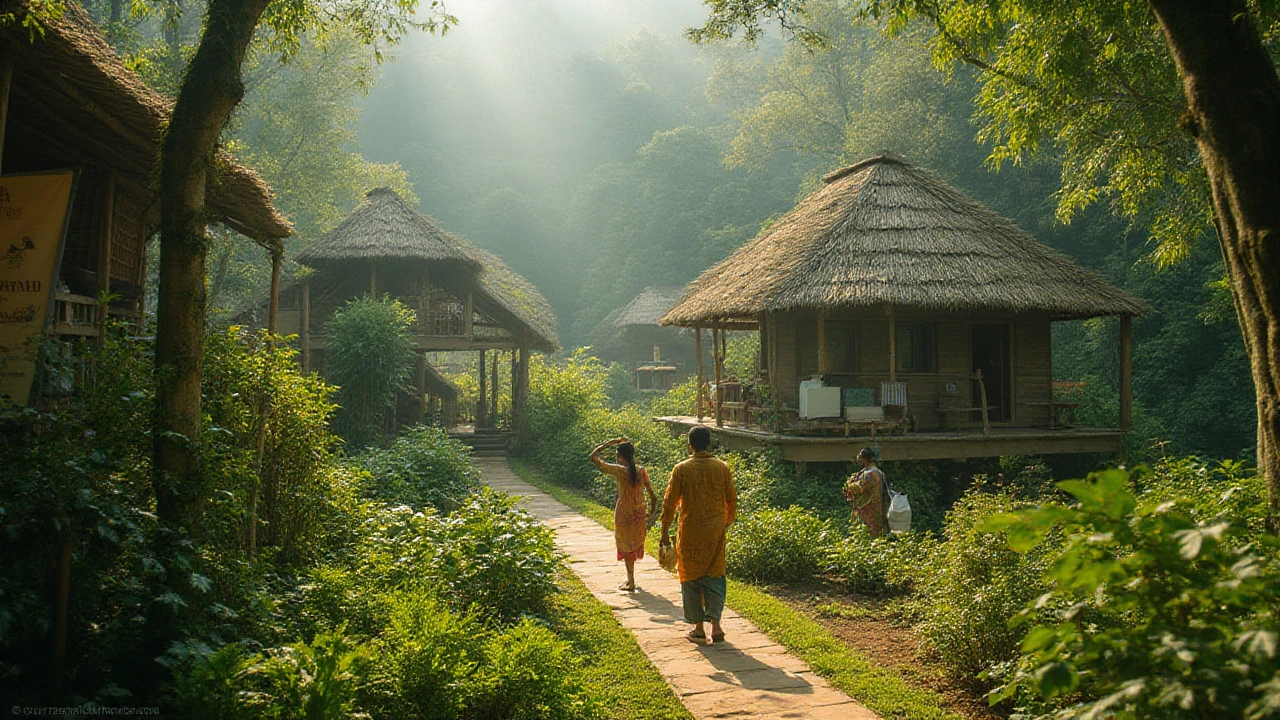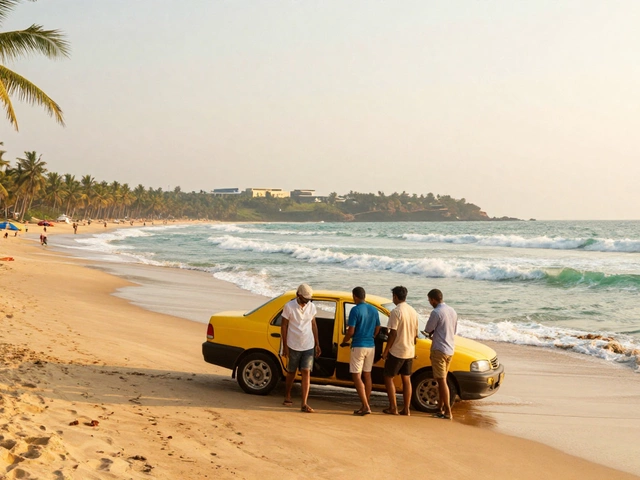Indian travelers are booking eco resorts in record numbers, but what does that label actually mean? People imagine solar-powered bungalows in jungles where you wake to birds instead of blaring traffic, but is it all just marketing? When a beachside hotel claims they’re 'green,' does that mean anything real—like, will your stay actually help the planet? Or is it just a towel reuse sign and an organic salad thrown on the menu?
What Exactly Is an Eco Tourist Resort?
Let’s get this straight: an eco tourist resort goes way beyond skipping plastic straws. These places are built to blend into their surroundings instead of bulldozing over them. It’s about shrinking their footprint and giving back to local communities and wildlife, not just doing the bare minimum because it looks good on social media.
Picture a resort on the edge of a tiger reserve in Madhya Pradesh. Instead of draining local rivers for a mega swimming pool, the property might use rainwater harvesting to keep things green without drying up resources for everyone else. Or think of mountain lodges in Uttarakhand that build with locally sourced materials, avoiding shipping marble halfway across the world. Some go as far as operating entirely off-grid—solar power, biogas, even composting toilets.
According to a 2024 study in Nature Sustainability, true eco resorts focus on: protecting biodiversity, managing resources responsibly, and boosting community livelihoods. Forget those places where they just hang a few recycled art pieces and call it a day. At a real eco resort, you should feel the difference as soon as you arrive—the construction, food served, staff, and activities all reflect the local environment and culture.
Eco resorts often limit the number of guests to avoid overcrowding sensitive areas. In Kerala, many eco resorts track energy use per guest and set caps on how much water each room can consume.
So, if you’re dreaming of a guilt-free getaway, look for certifications like Green Globe or EarthCheck (but don’t just trust a fancy badge—some mean more than others). Actually, in India, some local organizations run audits stricter than international labels.
How Eco Resorts Protect Nature and Wildlife
The best eco tourist resorts don’t just sit pretty in the wilderness—they actively guard it. Take the tiger corridors around Pench National Park: some eco lodges have helped plant native trees to reconnect animal habitats that development once chopped apart. That’s not just good PR; migratory patterns and wildlife numbers have rebounded where resorts partnered with conservationists.
Waste management is a big deal. Top eco retreats in Goa and Himachal Pradesh sort all garbage on site, compost food scraps, and even turn used glass into building material. Water usage can make or break a resort’s eco rating. Many smart resorts use treated greywater—basically, lightly used water from sinks and showers—to irrigate garden beds so they’re not draining streams dry.
Energy? The move is toward renewables. Take Chumbi Mountain Retreat in Sikkim: the place runs almost totally off hydro and solar. In 2025, they reported cutting their carbon emission per guest by 75% compared to standard hotels nearby.
Then there’s food. Forget imported avocados and plastic-wrapped snacks flown from Dubai. The top eco resorts feed you local cuisine, grown literally meters away in organic gardens or sourced from neighboring farms. Not only is your thali fresher, but you’re cutting food miles (and sometimes your own papaya, right from the tree).
Responsible wildlife tourism means no animal selfies, no elephant rides, and definitely no petting wild creatures. Instead, you might join a birdwatching walk led by locals or help collect data for on-site scientists—the kind of stuff that actually helps protect endangered species.
Eco tourist resort operators also train their staff in sustainable practices. It’s not rare to find resorts that run guest nature programs or eco-workshops, teaching people about local flora and fauna. Table below shows real stats from leading eco resorts in India reported in 2024 by the India Sustainable Tourism Alliance:
| Eco Resort | Energy Supply | Waste Managed On-site | Local Community Employment (%) |
|---|---|---|---|
| CGH Earth, Kerala | 90% solar/biogas | 85% | 74% |
| Evolve Back, Coorg | 80% hydro/solar | 92% | 82% |
| Sujan, Rajasthan | 60% solar | 88% | 67% |

The People Side: Eco Resorts and Local Communities
This is where so many supposedly 'green' hotels fail—they forget people live around them. Authentic eco resorts put locals at the center, not just on the edges as workers. When you check into a place in Spiti or Kaziranga that greets you with a homemade meal, know those recipes probably came straight from a neighbor.
Some eco resorts are actually owned or co-managed by communities. In Meghalaya’s Living Root Bridge villages, the guides are residents, and profits from hosting guests pay for local schools or clinics. A growing trend in 2025 is for resorts to partner with tribal or farming cooperatives for everything from honey production to bamboo crafts.
Genuine engagement goes deeper than a once-a-week cultural night. The best eco resorts invite you to join agricultural work, weaving, or conservation—real experiences, not staged shows. Guest dollars go back to building up the village, fixing roads, and funding forest patrols instead of just lining corporate pockets.
Language preservation is another cool side effect. Resorts in Ladakh or Nagaland often employ local educators to run language classes for staff and guests. In 2024, over half the eco resorts surveyed by the Indian Institute for Sustainable Tourism reported supporting local education initiatives.
Women’s empowerment can be a huge plus. At resorts in Uttarakhand and the Sundarbans, you see female guides, managers, and artisans featured front and center. It creates jobs where usually women would be stuck with unpaid home labor. Many eco resorts now track not just community jobs, but family health and school attendance, to check their real-world impact.
Don’t be shy—ask staff about the resort’s community policies. If they hem and haw, or say ‘we donate,’ that’s a red flag. If they beam and reel off the ways they’re involved, you’re in a place that walks the talk.
How to Identify a True Eco Tourist Resort
Greenwashing is everywhere. That’s when brands pretend to be eco-friendly but do the bare minimum—or worse, just fake it. So how can you tell if a resort is really sustainable, or just playing to the 'eco chic' crowd? Here’s what to watch for:
- Certifications matter, but dig deeper. Some, like EarthCheck or the Indian government's Eco-Tourism Certification, require tough annual audits. Others are mostly self-reported checklists.
- Transparency is key. Reputable resorts post their sustainability numbers—energy, water, waste—on their website or lobby walls. Vague claims like 'committed to nature' mean little.
- Look for local flavor everywhere. If the staff is mostly from far away, or the décor could be anywhere in the world, they might just be slapping an 'eco' sticker on a normal hotel.
- Check the menu. Local, seasonal food is hard to fake. An 'international buffet' full of air-freighted cheese isn’t sustainable.
- Community involvement shows. Ask: Do local people co-own or benefit from the resort? Do they run tours and workshops?
- Quiet luxury is a hint. If your room has five air-conditioners and a jacuzzi, it’s not really green, no matter how many trees they plant on check-in.
There’s also the feel of the place. Does staff seem happy? Is wildlife thriving? Are you encouraged to learn and participate, or just sit by the pool? In 2023, Travelife reported that properties with true eco credentials get better guest reviews, especially about the staff and surrounding nature.
Technology is playing a new role. QR codes in rooms can tell you where water’s sourced, how energy is generated, or the story of the person who grew your breakfast bananas. Smart meters and apps help some resorts let guests track their own impact and suggest ways to lower it, like taking shorter showers or joining guided hikes instead of vehicle safaris.
One last tip: Social media can help or hurt transparency. Some reputable eco resorts use Instagram to show real-life composting or repairs, not just sunset photos. Check reviews that mention sustainability specifics, not just 'pretty views.' Reddit and blogs are gold mines for honest feedback.

Tiny Steps: What Eco Travellers Can Do at These Resorts
Even the greenest resort can only do so much—travelers matter too. You get to decide how lightly you tread. First up: Consider how you arrive. Trains and buses have way lower carbon emissions than flying (for example, Mumbai to Goa by train emits 1/8th the carbon of a flight, per 2024 Railways data).
When you’re there, follow the resort’s eco policies. That might mean refilling your bottle at a water station, skipping fresh towels each day, or joining a tree-planting walk. If they offer volunteer programs in wildlife monitoring or reef restoration, jump in—even a few hours can make a difference.
Respect is everything. Don’t pick flowers or sneak animal snacks. Stick to trails. Ask before taking photos of people or ceremonies. It sounds basic, but too many travelers still forget—they’re guests in someone else’s home.
Remember, souvenirs mean more if they’re made by local hands, with stories you learn directly. Support village-run markets instead of import shops. Join cooking, farming, or handicraft workshops led by residents to give back and truly understand where you’re visiting.
If you see something that doesn’t look right—maybe single-use plastics, poor waste handling, or unethical wildlife practices—call it out politely. The best eco resorts welcome (even request) feedback because they want to improve.
And finally, be curious! Dive into conversations with staff and guides, ask what makes their resort different, what challenges they face, what they’re proudest of this year. Chances are, you’ll come home not just refreshed but with a whole new perspective on travel’s real impact.









